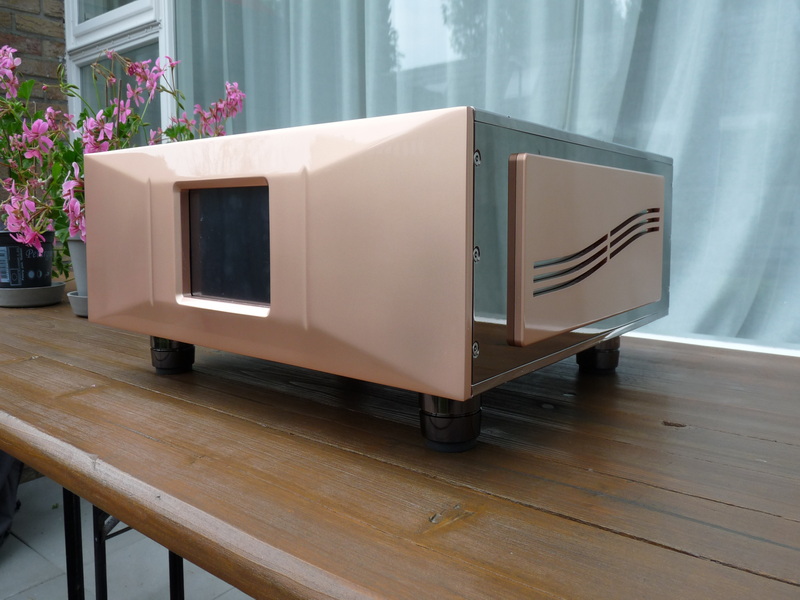Review:Merrill Audio Element 114 and Christine – US-based Merrill Audio builds amplifiers and has a modest portfolio. The devices don’t just have a striking appearance. They are solidly built and under the hood are special design choices that set Merrill Audio’s products apart from the competition. Merrill Audio, for example, uses gallium nitride semiconductors. Does Merrill Audio’s engineering and design choices lead to a good reproduction of music? Our test room has power amplifier Element 114 and preamplifier Christine. We investigate.
Merrill Audio: “AudioPurity”

Merrill Audio is an audio company based in Bernardsville, USA, dedicated to the manufacture of amplifiers. Founder and Chief Designer Merrill Wettasinghe is the driving force behind the company. According to the description on the company’s website, Merrill Wettasinghe has technical training, but played the piano from an early age. At the same time he was busy building electronic circuits. What is an audiophile, Merrill Wettasinghe wondered? A lover of music? Or a lover of a beautiful sound? Probably both, says the head of Merrill Audio.
.jpg)
Because Merrill Wettasinghe had and has knowledge and interest in both technique and music, he said he viewed things from both angles. Musicians must have very refined motor skills. Speed is the keyword. A pianist’s finger movements are the fastest movements a person can make (no, an experienced typist is not faster). According to Merrill Audio, a high-quality amplifier is also characterized by speed, speed and speed. The result is “Audio Purity” according to Merrill Audio. We will look at that in more detail in a moment.
Merrill Audio: portfolio of amplifiers
Merrill Audio’s current portfolio is relatively modest. The company offers three power amplifiers, of which the Element 118, a mono amplifier, is the largest. The Element 116, also a mono amplifier, is a bit smaller. Our test model Element 114, the only stereo amplifier, is the smallest model.
.jpg)
Merrill Audio offers one model of preamplifier, our test model Christine. There is also the Jens Phono Stage, a phono amplifier (the Christine has no turntable input). Then there are two somewhat special preamps, the Master Trident and the Master Tape Head Preamps. These devices are intended to amplify the signal from the heads of a reel recorder or cassette deck to line level. The Tape Head Preamps are more likely to find their way into a professional environment such as a studio than a living room.
Merrill Audio also sells power cords, interlinks and speaker cables. Incidentally, according to the company’s website, work is underway to expand the portfolio by adding an integrated amplifier, phono amplifiers and digital products.
Our test room contains stereo power amplifier Element 114 and preamplifier Christine. We will first take a closer look at both devices before saying something about the sound.
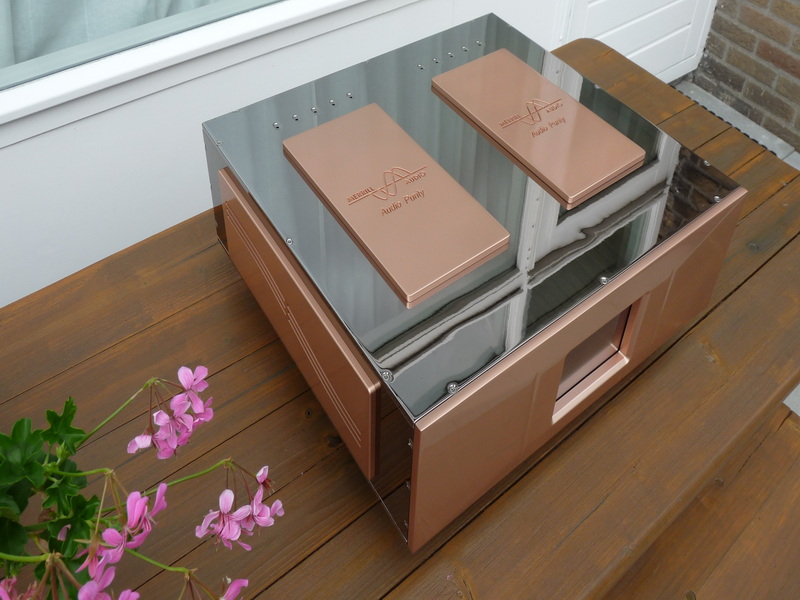
All Merrill Audio power amplifiers feature a rose gold front and top and side plates, which, however, do not cover the entire surface. The rest of the surface of the top and side and also the back is made of shiny nickel. Likewise, the Element 114 power amplifier. Yes, it mirrors properly and it is very sensitive to fingerprints. It’s a “love-it-or-hate-it” design. The Element 114 has no controls, not even a main switch. The user cannot set anything, which is normal for a power amplifier.
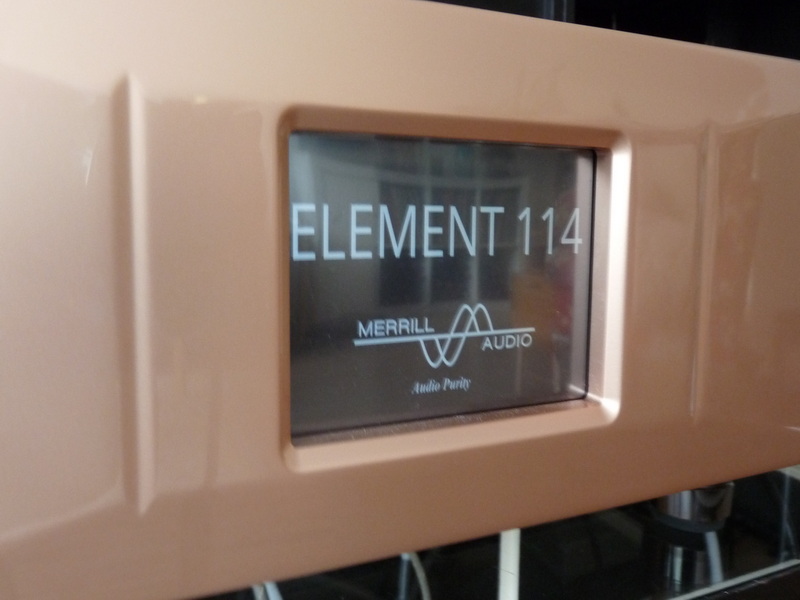
In the center of the front is an OLED touch display that, if the amplifier is connected to the mains, shows the product name and the logo of the manufacturer. The display can be dimmed by touching the top right corner. A swipe across the screen shows the firmware version. There is nothing more to operate on the Element 114. In our opinion, the Element 114 would also function well without the OLED touch screen. An on / off indicator LED would suffice.
Merrill Audio has equipped the Element 114 with Isoacoustics type GAiA III feet that effectively decouple the amplifier from the ground. For inputting music signal, a single pair of XLR connectors is fitted with silver pins covered with a layer of rhodium. The very solidly designed speaker connections from WBT are made of copper and also covered with a layer of rhodium. They accept banana plugs, forks or bare wire. The power supply comes in through a 20A socket from Furutech.
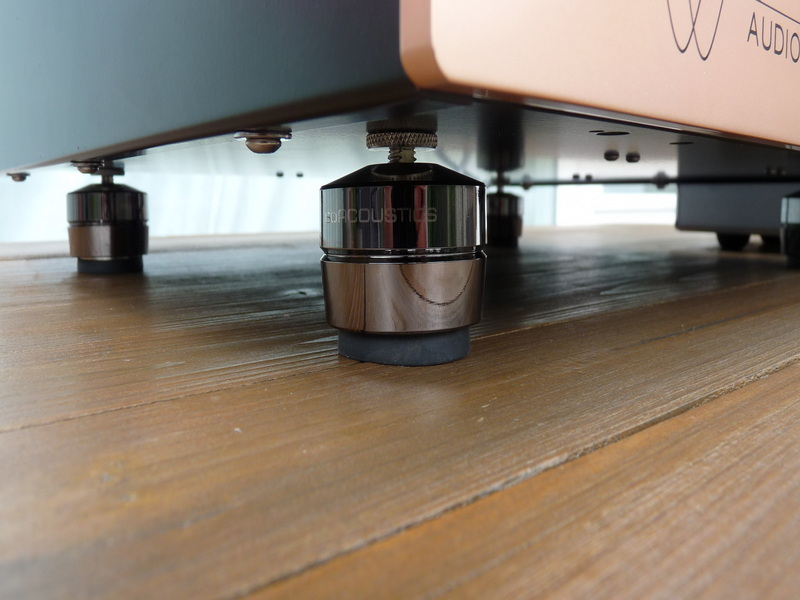
Merrill Audio has not placed any markings on the back to distinguish right and left. Not a disaster, but Merrill Audio seems to have simply forgotten the designations. The importer had already noticed and asked the manufacturer: the left XLR connection corresponds to the left speaker connection.
Merrill Audio has also used special unique screws to screw the case closed. Pictures of the inside are nowhere to be found, nor can you take them without damaging the screws and / or the housing. Merrill Wettasinghe prefers to talk about sound rather than technique and snoopers are not wanted.
Furthermore, almost every heavy power amplifier emits a soft 50 Hz hum. Not like the Element 114. If you put your ear on the top, you won’t hear anything at all. All parts that can vibrate are apparently well secured. The heat development is low. The Element 114 doesn’t get more than lukewarm, even if it is played louder for a while.

Everyone can decide for themselves whether the Element 114 is beautiful to see. The fact is, however, that the connections and the housing give a very solid impression. We have never seen / heard a power amplifier as quiet as the Element 114 before. The complete absence of a 50 Hz hum is a surprise.
Merrill Audio Element 114: features and technology
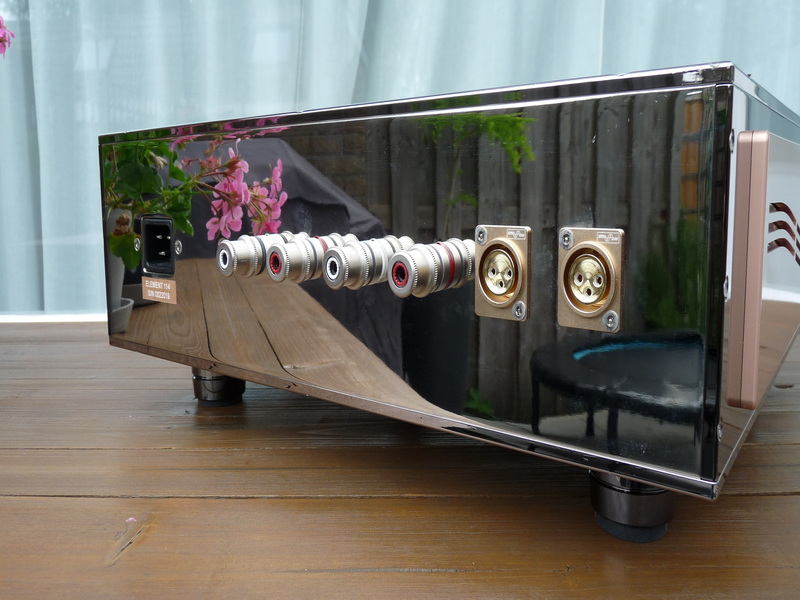
The basis of the Element 114 is a Class D amplifier circuit that is fed from a custom LLC resonant power supply with a custom transformer. The Element 114 is “load invariant” according to Merrill Audio. This means that the Element 114 supplies power to all complex loads, doubling the power when the impedance is halved. In concrete terms, the Element 114 delivers 200 watts per channel at eight ohms, 400 watts at four ohms and 800 watts at two ohms. The outputs are protected against clipping dangerous for loudspeakers. The specified S / N ratio is 110 dB.
Merrill Audio Element 114: gallium nitride transistors
Semiconductor material was invented roughly in the mid-twentieth century. The first transistors (and diodes) were made of germanium. Some time later Germanium was succeeded by silicon. It is going too far to discuss all semiconductor materials. The fact is, however, that the substance gallium nitride (GaN) was discovered at the end of the twentieth century as a very suitable semiconductor material. It took another ten years before gallium nitride transistors were produced on a large scale. Gallium nitride transistors can operate at high voltages and very high frequencies. They are also more resistant to high temperatures and less energy is lost.
Using gallium nitride transistors and advanced PCB design techniques, the dead time is reduced to zero, which, according to Merrill Audio, eliminates any distortion. What is Dead Time? Merrill Audio explains, “Deadtime is the time it takes for the MOSFET or transistor to discharge or charge when the state changes. Since there is no dead time distortion, the proprietary design called ZXOL also has zero feedback ”. ZXOL stands for zero crossing and open loop design.
Gallium nitride transistors can handle frequencies in the gigahertz spectrum (yes, they are also in microwave ovens) and Merrill Audio has chosen gallium nitride transistors for the switching speeds these transistors can handle effortlessly.
We are going to take a closer look at preamplifier Christine.
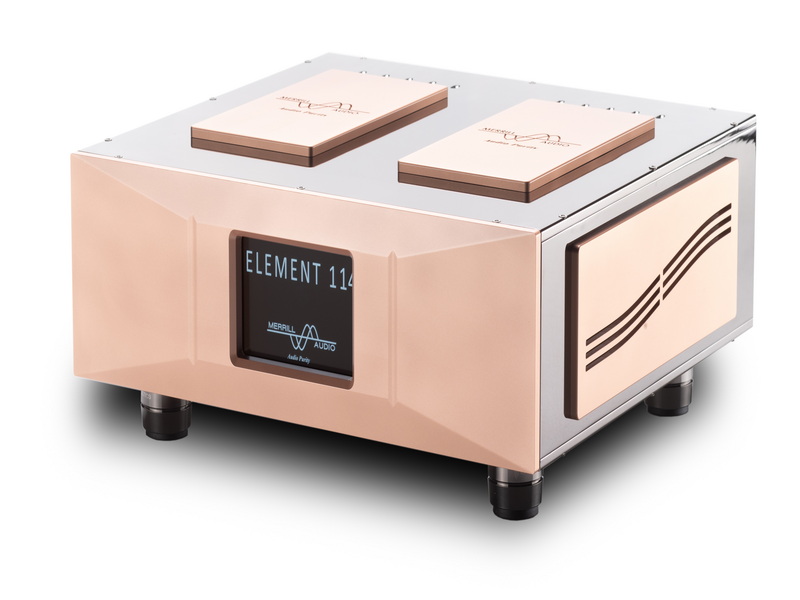
Merrill Audio Christine and Kratos: preamplifier with external power supply
The top of the Christine is matte black. The back is made of shiny nickel, just like the Element 114. The front is made of rose gold. A dot matrix display is placed in the center, consisting of four elements of 8×8 white LEDs each. Just like the Element 114, the Christine stands on Isoacoustics feet, which largely disconnect her from the ground.
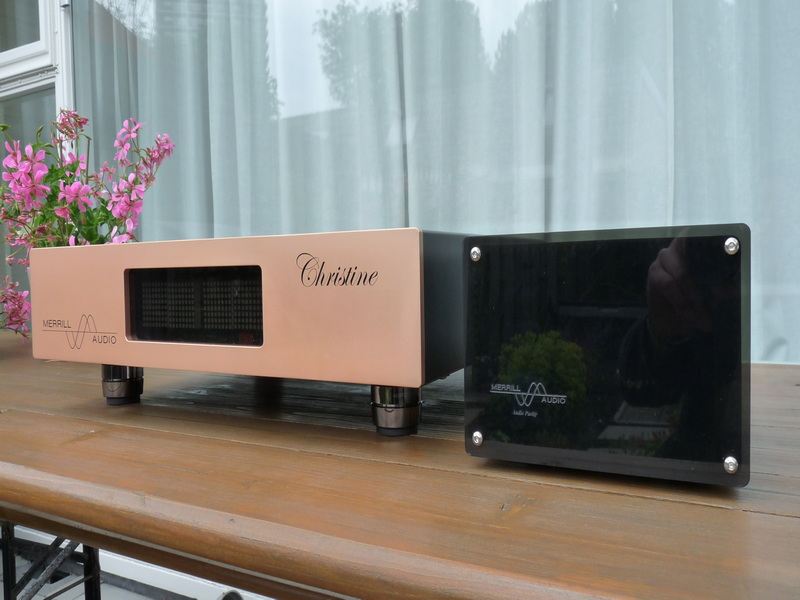
The Christine is powered from an external power supply called Kratos, which is included. The Kratos’ enclosure doesn’t quite match the Christine’s enclosure, but the Kratos doesn’t have to be in plain sight.
If we look at the back, the left-right layout of the inputs and outputs is striking. Left and right connections are not mixed together, but are in a section for the left and a section for the right. The user has access to four XLR inputs and two XLR outputs. The connections are of exemplary quality. The level of all inputs can be adjusted within certain limits (and the adjustment is saved). The Christine could therefore be used to drive two power amplifiers, whereby one power amplifier can get a little more or less signal than the other if desired. Incidentally, those who would like to use a cinch connection can achieve this by using XLR cinch adapter plugs.

Merrill Audio Christine: Control with an Apple IR remote

There are no controls on the front of the Christine. No volume control, no source selector or switches, no power button, nothing at all. According to Merrill Audio, the front of the Christine looks nice and tidy. Operation of the Christine is done with an included IR remote control from Apple.
That all kinds of deeper settings, such as the adjustment of the level of an input or output, cannot be made with buttons on the front, but that the volume control has also been tidy is less understandable. A rotary knob for volume control and a second rotary knob for source selection don’t immediately make the front cluttered? The advantage of controls on the front is that they can never be lost. And everyone, including visitors, understands how a rotary volume knob works.
When we look at the included remote control from Apple, we have a mixed feeling. In this price range, a nice sturdy intuitive IR remote control made of aluminum is more or less the norm. The Apple remote control is small and can be lost relatively easily. If the remote control is defective or lost or if the battery is empty, the Christine can no longer be operated. After a comment on this to the importer, this risk was immediately recognized. The Dutch importer will be supplying two Apple remote controls with the Christine with immediate effect. The user can safely store the second remote control just in case.

Using the Apple remote and adjusting deeper settings takes some skill. It is not intuitive, but the manual provides a clear description and deeper settings usually do not need to be adjusted or not so often.
Although we would have preferred a nice aluminum IR remote control, Merrill Audio’s choice of Apple’s remote control also has an advantage. If the remote control is lost or defective, the user can use any other remote control from Apple (and the Dutch importer therefore immediately supplies two remote controls with the Christine!). Christine’s manual describes how a new remote control can be paired with the Christine. A sturdy aluminum remote control can also break or get lost. Replacing a nice aluminum remote control is probably much more expensive than buying an Apple remote control. So you see, as the greatest philosopher in the Netherlands of all time said, “every disadvantage has its advantage”.
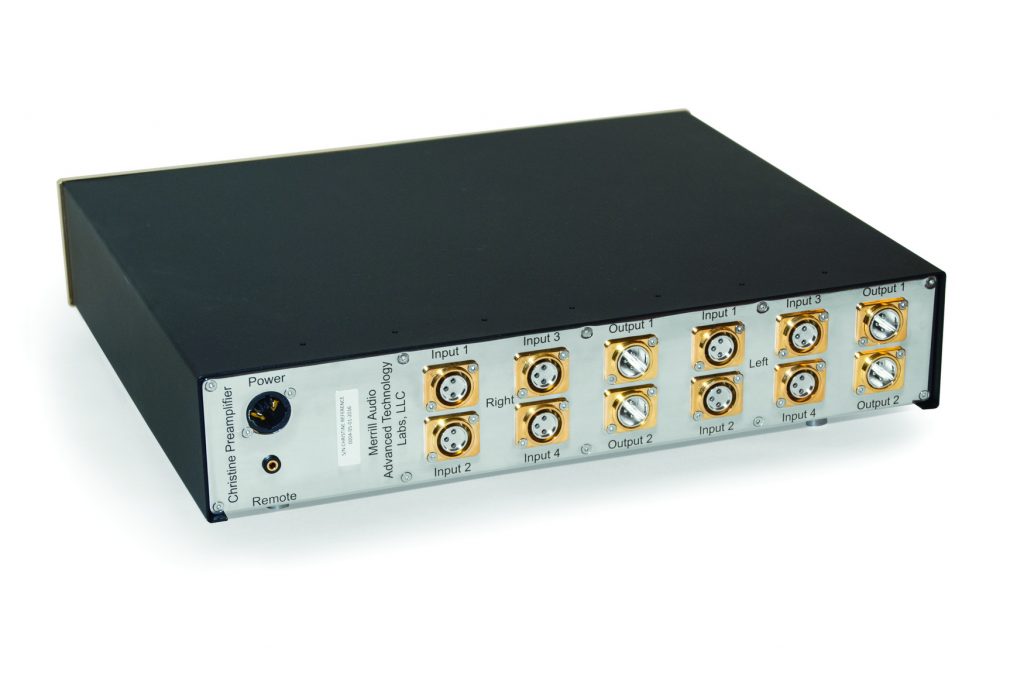
Merrill Audio Element 114 and Christine: test environment
The Element 114 is connected alternately to different sets of loudspeakers, ie a set of floor stands of KEF type R5, a set of floor stands of Piega type Premium 7 and a set of electrostatic speakers of Quad type ESL63. Music signal was supplied by a Wadia type 321 DAC DA converter which was connected to the Christine with XLR cables. The Wadia 321 DAC alternately received a music signal from a modified Sonos Connect and a DS-10, a streamer from the Italian Gold Note. Of course, a great diversity of music has been sent to the Christine through these components.
Press play.
Merrill Audio Element 114 and Christine: sound, neutral, rich in detail and a good drive in the low end.
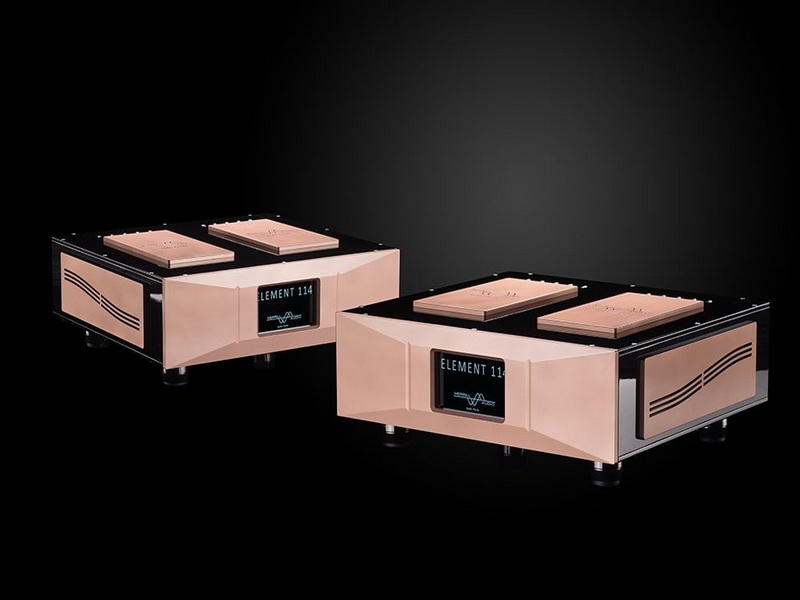
First of all, the extraordinary transparency of Merrill Audio amplifiers is striking. Instruments form an organic whole but can also be followed very well individually. The sound is rich in detail. If a breath of a vocalist is incorporated into the recording, that breath is not always perceptible, or not always noticeable. The set from Merrill Audio shows details that are often masked or omitted by other amplifiers. That also applies to breaths of vocalists.
Second, the completely neutral sound of the set stands out. Many amps have a sound with a slight hint of warmth or a very thin layer of velvety on the sound. This doesn’t have to be negative at all. Velvety should not be confused with wooliness. A little touch of warmth or velvety can sound very pleasant, as is often the case with tube amplifiers. Moreover, warmth or velvety does not have to obstruct the reproduction of micro details at all. Warmth and velvety are absent from the sound of the Merrill Audio set. But because of this neutral sound, any heat or coolness in the recording is noticed all the faster. The window on the recording is transparent.
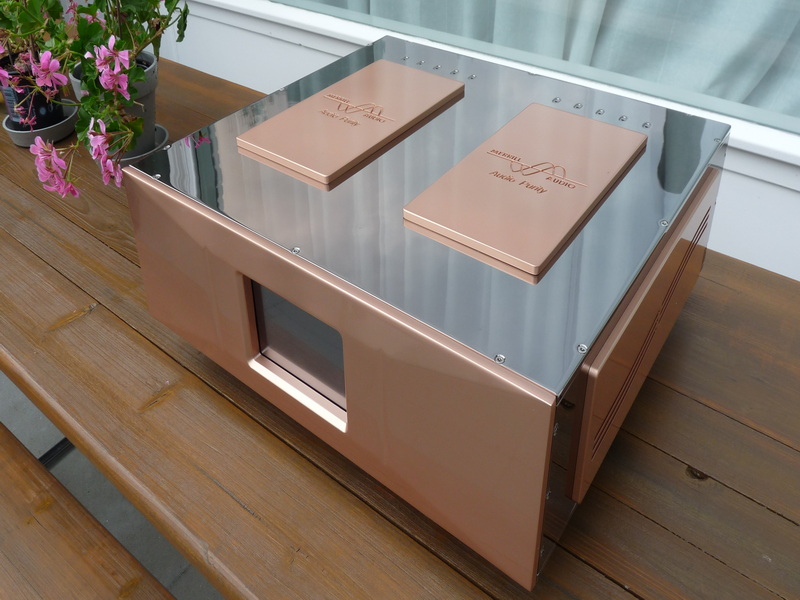
Bells, cymbals and a triangle sound realistic and linger for a long time before fading away. The soundscapes of Ozric Tentacles, for instance, usually a mixture of acoustic and electronic instruments, are a pleasure to listen to. The transparent sound at times invites you to close your eyes, as it were, to “look” concentrated in the recording. Merrill Audio prides itself on the speed, speed and speed of its amplifier circuitry. This philosophy will undoubtedly contribute to the end result: a transparent and clean sound.
The bass reproduction is tight and controlled. Not as punchy as a class A amplifier, but with great control, without a trace of wooliness. The Element 114 also has a certain drive in the low end. By this we mean to say that the reproduction of low tones in some pieces of music is just a bit more prominent than we are used to. However, this turns out to fit in very well with the Quad ESL63. This speaker is king when it comes to transparency and neutrality, but has a bass response that is perceived by some listeners as a bit too thin. The Element 114 turns out to be a very good combination with Quad’s electrostatic loudspeaker. The ESL63 can use the small push at the bottom.
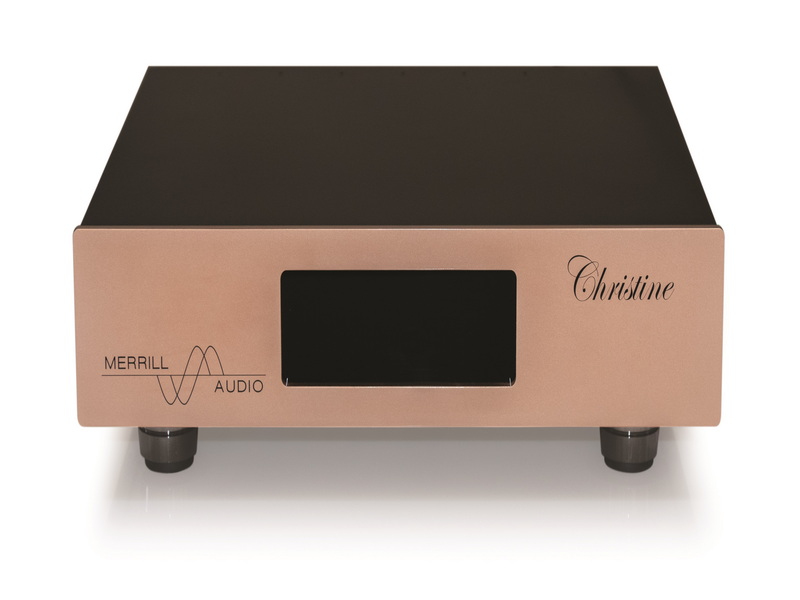
By way of illustration, the subtle accent differences in the low tones that can be heard in “Dream Sequence # 1” by the Belgian band dEUS (album The Ideal Crash) are a bit masked or simply not reproduced by many amplifiers. The set from Merrill Audio shows the differences in accent flawlessly. Control and speed are catchphrases that often cross our heads while listening. Garbage’s “Deadwood” (from the Bonus CD included with the 20th Anniversary Edition of the album “Version 2.0”) dives deep into the bass, on different levels. The Merrill Audios tightly control playback without adding wooliness or any other form of coloration. Merrill Audio has left out effect seeking. The listener does not get kicked in his / her stomach. Classical music can also plunge deeply, as for example in Tchaikovsky’s “Slavic March” performed by the Berlin Philharmonic Orchestra conducted by Claudio Abbado. The timpani become more and more explosive towards the end while the orchestra starts playing more and more fortissimo. The Merrill Audios do not budge and effortlessly process the large dynamic differences without the sound closing somewhere. We take a moment to sit back and forget about the passage of time. We are swept up in Tchaikovsky’s Slavic March. We take a moment to sit back and forget about the passage of time. We are swept up in Tchaikovsky’s Slavic March. We take a moment to sit back and forget about the passage of time. We are swept up in Tchaikovsky’s Slavic March.
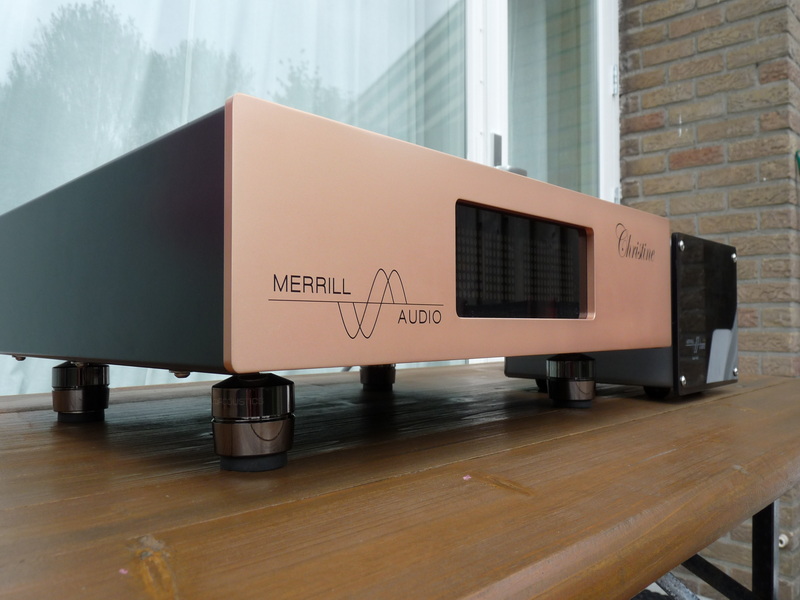
Tool’s album “Fear Inoculum” also has great dynamics. “Chocolate Chip Trip” has a strange structure and may not be the most musical song on this album, but the very dynamic wall-to-wall sounding drums are reproduced so realistically that the drummer seems to be sitting in the room. The Merrill Audio set sucks us into the recording. The rustling cymbals in A Perfect Circle’s “Eat The Elephant” seem to be in the room as well. At the same time, the piano plunges into the depths. Many amplifiers have difficulty with correctly and realistically reproducing the interaction of cymbals and piano. The Merrill Audios don’t budge. This is how the cymbals and the piano should play and sound together. Almost unnoticed, time passes while we enjoy the music.
It doesn’t matter what the Merrill Audio amplifiers get. Each time they behave as a transparent, neutral and colorless window on the image. If there is a sound, the sound is in the recording or the connected speakers. The KEF R5 has a slight hint of warmth while the Piega Premium 7 has a more neutral sound with a small edge of coolness. The ESL63 from Quad is a resolution champion that lets you hear everything in the recording. The amplifiers clearly show the differences between the speakers.
In short, the sound is neutral, transparent, rich in detail with a very little extra push in the bass. The set does not seem to be critical when it comes to choosing a speaker. Not all amplifiers can handle electrostatic speakers well, but the Element 114 has no problem with it.
Place in the market, who is this set of amplifiers for?
Merrill Audio’s Element 114 is a power amplifier without controls, which is not uncommon for a power amplifier. However, the Christine also has no controls, which is less common for a preamplifier. Indeed, the front has been tidy and has no buttons. The buyer will have two IR remote controls from Apple. So it must be strange to come to an unmanageable Christine.
We understand Merrill Wettasinghe’s design choice for the Christine’s sleek front and it is of course everyone’s own choice whether to go along with it or not. The assessment of the appearance of both devices is also up to the buyer. We have had different reactions from visitors to the listening room, ranging from “oh, how beautiful” to “this shiny stuff is not coming into my house”. We do not judge the appearance of the amplifiers. After all, this is largely a matter of taste.
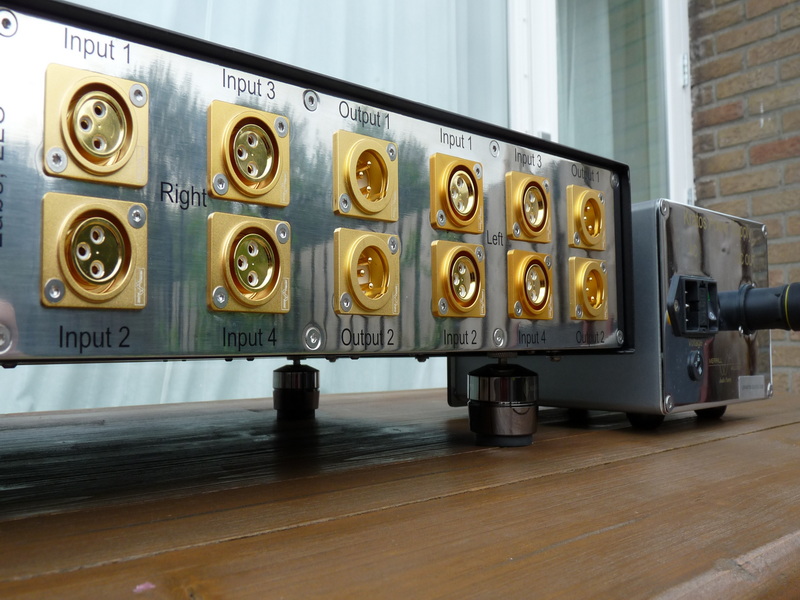
This does not alter the fact that the build quality of both amplifiers is excellent. Connections and feet are of exemplary quality and the cabinets are very solidly built and seem to have a long life ahead. The Element 114 weighs twenty kilograms and more power amplifiers do that. However, the Element 114 distinguishes itself from the vast majority of its competitors by its dead-quiet operation. The 50 Hz hum of the power transformer (s) that is perceptible with many amplifiers is absent from the Element 114.
When it comes to sound, we can say that the Merrill Audio Element 114 and Christine are at the top of the market. The almost limitless frequency range that extends well beyond the frequency range of sources and speakers is an indication of what lead designer Merrill Wettasinghe is pursuing and that is speed, speed and more speed. The result is a set of amps that sound neutral, transparent and rich in detail. Control and grip on the connected speaker is guaranteed regardless of the speaker type. Investments have been omitted. The set from Merrill Audio seems intended for both the audiophile and the non-audiophile-minded music lover.
Merrill Audio Element 114 and Christine: conclusion
The Merrill Audio Element 114 and Christine evoke both very positive and negative reactions with their appearance. You like them or you don’t. However, the build quality is very good. Special technology is located underneath the surface, whether valued or not. The result is a transparent, neutral and detailed sound regardless of the position of the volume knob. Control and grip on the speaker are of a very high level. The listener can choose to be carried away with the music or sit on the edge of his seat to look deep into the recording.

PLUS POINTS of Merrill Audio Element 114 and Christine
- Neutral and transparent sound
- Let us hear all the details
- Listener can “look” deep into the recording
- Impeccable build quality
- Very quiet power amplifier without hum
MINUSES of Merrill Audio Element 114 and Christine
- The appearance must appeal to you
